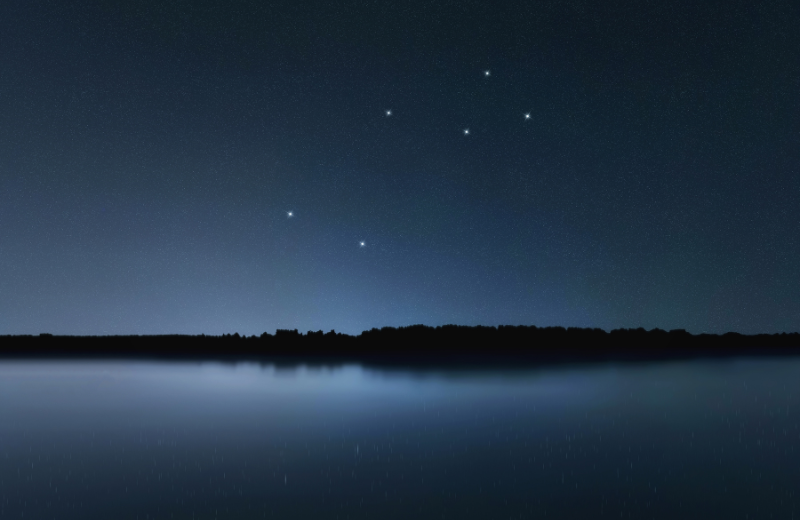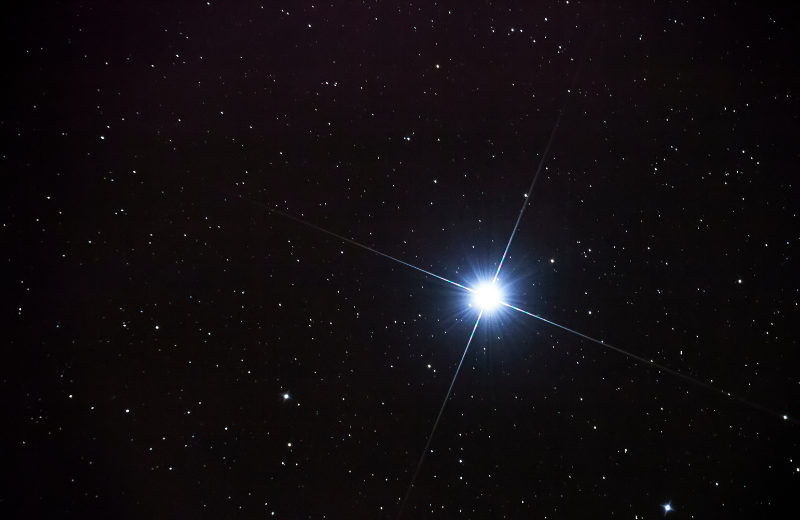The Lyra constellation, also known as the Harp constellation, is one of the most fascinating and beautiful groupings of stars. Whether you’re a seasoned stargazer or just getting started, this guide will help you understand the Lyra constellation and its stars.
Jump to:
What is the Lyra Constellation?

Lyra is a small constellation located in the northern sky. It is named after the lyre, a musical instrument similar to a small harp. This constellation is easily identifiable due to its brightest star, Vega, which is one of the most luminous stars in the sky.
The Lyra Constellation Myth
In Greek mythology, Lyra is associated with the myth of Orpheus, the musician who could charm anyone with his lyre. According to the legend, Orpheus' music was so beautiful that it could make trees dance and rivers stop flowing. After his tragic death, his lyre was placed in the sky by the gods to honour his musical talents. This is why Lyra is also referred to as the Harp constellation.
What Does the Lyra Constellation Symbolise?
Lyra symbolises music, artistry, and harmony. Its association with the lyre, an instrument of great beauty and sound, makes it a symbol of creativity and the arts.
What Galaxy is Lyra In?
Lyra is part of our Milky Way galaxy. It does not belong to any other galaxy, but it contains interesting astronomical objects like the Ring Nebula (M57), a famous planetary nebula.
How to Pronounce Lyra
Lyra is pronounced as "LYE-rah," with the emphasis on the first syllable.
Lyra’s Stars

Lyra contains several notable stars, but the most famous by far is Vega.
Lyra's Brightest Star: Vega
Vega is the fifth-brightest star in the night sky and the second-brightest star in the northern celestial hemisphere. It is relatively close to Earth, at a distance of about 25 light-years. Because of its brightness and position, Vega has been an important star for navigation and astronomy.
Other Notable Stars in Lyra
While Vega steals the spotlight, Lyra has other interesting stars, including:
- Sheliak (Beta Lyrae): A binary star system that is quite unique due to the way its components eclipse each other, causing variability in brightness.
- Sulafat (Gamma Lyrae): Another bright star in Lyra, notable for its blue-white hue.
- Delta Lyrae: A binary star system with a significant colour contrast, making it a popular target for amateur astronomers.
- Epsilon Lyrae: Known as the "Double Double," this star system consists of two double stars that can be seen as separate stars through a small telescope.
- Zeta Lyrae: A pair of stars that appear close together in the sky, although they are not physically related.
- RR Lyrae: A variable star that serves as the prototype for a class of pulsating variables, which are important as standard candles for measuring astronomical distances.
- Kappa Lyrae: A lesser-known star that is still notable for its contribution to the constellation’s structure.
Finding Lyra in the Sky

Lyra is best seen in the northern hemisphere during the summer months, especially in July and August. Its small size and distinctive shape make it relatively easy to locate once you know where to look. Here’s how you can find Lyra and enjoy its stellar beauty, whether you’re using the naked eye, binoculars, or a telescope.
Locating Lyra
To locate Lyra, first find Vega, the constellation's brightest star. Vega is one of the most brilliant stars in the sky and can be found high in the eastern sky during summer evenings. Vega forms part of the Summer Triangle asterism, along with Deneb (in the constellation Cygnus) and Altair (in the constellation Aquila). The Summer Triangle is a large, nearly equilateral triangle that dominates the summer night sky, making it a helpful reference point.
Once you've identified Vega, you can find the rest of Lyra. The constellation itself is shaped somewhat like a small parallelogram or rhomboid, with Vega marking one corner. From Vega, look for the stars Beta Lyrae (Sheliak) and Gamma Lyrae (Sulafat) to form the shorter base of the parallelogram. Delta Lyrae and Zeta Lyrae complete the shape.
Viewing Lyra with Binoculars or a Telescope
While Vega and the main stars of Lyra can be easily seen with the naked eye, binoculars or a small telescope will enhance your viewing experience, allowing you to see more details and some of Lyra's other intriguing features.
- With Binoculars: Binoculars will bring out more stars in Lyra, including the "Double Double" star Epsilon Lyrae. This star appears as a single point to the naked eye but resolves into two closely spaced stars when viewed with binoculars.
- With a Telescope: A small to medium telescope can reveal even more of Lyra's wonders. Epsilon Lyrae is particularly fascinating as each of the two stars seen with binoculars is itself a double star, making a total of four stars visible through a telescope. You can also observe Beta Lyrae's variability in brightness due to its binary nature and enjoy the beautiful colour contrast in Delta Lyrae's binary system.
Special Features to Observe
- The Ring Nebula (M57): One of Lyra's most famous deep-sky objects, the Ring Nebula, can be found between Beta Lyrae and Gamma Lyrae. This planetary nebula appears as a small, smoky ring through a telescope and is a stunning example of a dying star shedding its outer layers.
- RR Lyrae: This variable star is significant in astronomy as a prototype for a class of pulsating variables. Observing its changes in brightness over time can be a rewarding challenge for amateur astronomers.
The Best Viewing Times
Lyra is best viewed in the summer months, with optimal visibility from mid-June to early September. During this period, it is high in the sky in the early evening, providing excellent viewing conditions. For the best experience, find a dark location away from city lights, and give your eyes time to adjust to the darkness.
Fun Facts About Lyra the Harp
Lyra holds several intriguing scientific facts. Here are some fascinating tidbits about this celestial harp that make it a standout in the night sky.
- Lyra and the North Star: Vega was the North Star around 14,000 years ago and will be the North Star again in about 12,000 years due to the precession of the Earth's axis.
- Planet Lyra: There are several exoplanets that have been discovered in the Lyra constellation, making it a point of interest for astronomers studying planetary systems.
- Astrophysical Importance: Vega has been extensively studied by astronomers because of its brightness and proximity to Earth. It has helped in the calibration of photometric brightness scales.
Recommended for you!
Best SellersFrequently Asked Questions About the Lyra Constellation
What is special about the Lyra constellation?
Lyra is special for several reasons. It contains Vega, one of the brightest stars in the sky, and is rich in mythology, being associated with the story of Orpheus. Additionally, it houses fascinating astronomical objects like the Ring Nebula (M57) and multiple star systems such as the "Double Double" (Epsilon Lyrae).
Is Lyra the North Star?
Lyra is not the North Star. However, its brightest star, Vega, was the North Star around 14,000 years ago and will be again in about 12,000 years due to the precession of the Earth's axis.
What does Lyra mean in astrology?
In astrology, Lyra is often associated with creativity, harmony, and artistic talents due to its mythological connections with the lyre and Orpheus. It’s believed to inspire artistic expression and musical abilities.
What is the history of the star Lyra?
The history of Lyra dates back to ancient times, with its association to the myth of Orpheus and the lyre. Its stars, particularly Vega, have been significant in navigation and astronomy throughout history.
What does the constellation Lyra translate to?
The constellation Lyra translates to "the Lyre" or "the Harp" in Latin, reflecting its shape and mythological background.
Is Lyra part of the Zodiac?
Lyra is not part of the traditional Zodiac, which consists of 12 constellations along the ecliptic path.
What is the animal in the Lyra constellation?
The Lyra constellation does not represent an animal. It is symbolised by a lyre or harp, associated with the Greek myth of Orpheus and his musical instrument.
Study Astronomy for £29
If you’re fascinated by the stars and want to learn more about the universe, consider enrolling in our Astronomy Diploma Course at Centre of Excellence. You’ll gain a detailed understanding of the stars, planets, and celestial phenomena, all from the comfort of your own home. Sign up today for a discounted price of £29 and start your journey into the cosmos!













